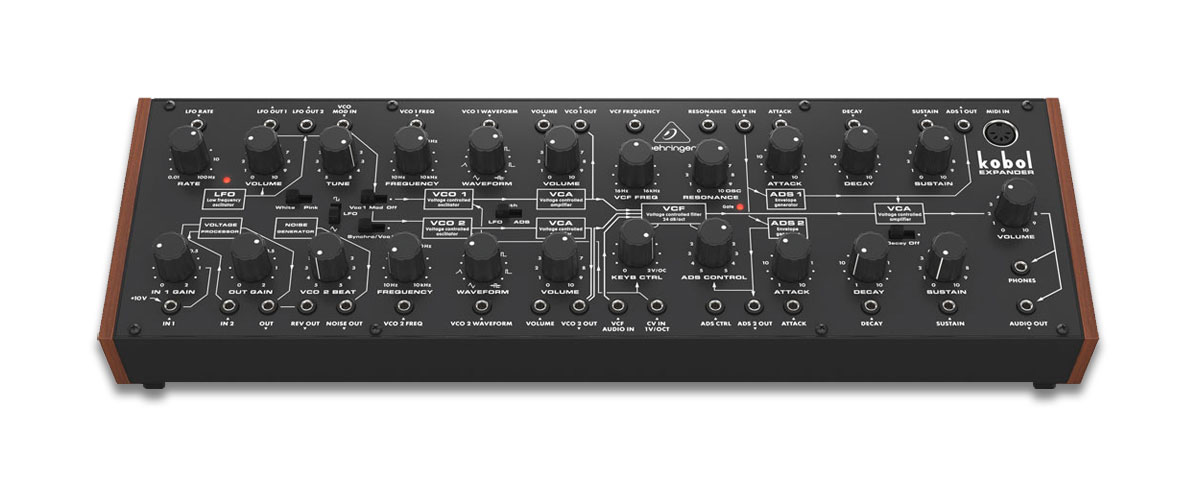BEHRINGER KOBOL EXPANDER - Sonic Alchemy and Modular Power in a Compact Form

Behringer Kobol Expander is a modern interpretation of the original RSF Kobol Expander, one of the most significant French analog synthesizers of the 1970s.
History and Development of Behringer Kobol Expander
The original Kobol Expander was used by many renowned musicians, including Jean-Michel Jarre, who incorporated it into his electronic compositions. This instrument was highly regarded for its unique wave morphing system, allowing smooth transitions between different waveform shapes. Behringer decided to revive this iconic synthesizer, preserving its analog character while adding modern connectivity and a semi-modular design.
Operating Principle of Behringer Kobol Expander
Behringer Kobol Expander operates on fully analog synthesis, meaning that its sound is generated using analog oscillators, a filter, and an amplifier.
Key Features of the Synthesis
• Two independent VCO oscillators – Each oscillator offers seven different waveform
shapes, which can be smoothly morphed.
• 4-pole analog VCF filter – A naturally saturating filter that delivers rich analog character.
• LFO with two waveform types – Enables modulation of various parameters.
• Noise generator – Adds texture and depth to synthetic sounds.
• Two ADS envelopes – Allow for precise sound shaping.
• Poly-chain mode – Allows linking up to 16 units for complex polyphonic sequences.
Structure and Controls of Behringer Kobol Expander
Behringer Kobol Expander is a semi-modular synthesizer, meaning it can operate independently, while also offering 32 patch points for modular integration.
Main Control Features
• Knobs for oscillators, filter, envelopes, and modulation – Direct control over key sound
parameters.
• Wave morphing – Enables smooth transitions between different waveform shapes.
• Patch section – 32 CV input/output points for modular integration.
• MIDI and USB connectivity – Easy integration with DAW and external devices.
Detailed Overview of Behringer Kobol Expander's Control Panel
• Oscillators (VCO 1 & VCO 2)
• Wave Morphing Knob – The signature feature of Kobol Expander. Allows seamless transitions
between different waveform shapes (saw, square, triangle, sine, pulse).
• Frequency Knob – Adjusts oscillator frequency (tuning).
• Fine Tune Knob – Enables precise tuning for accurate pitch control.
• Pulse Width Knob – Controls pulse wave width, affecting the harmonic content of the sound.
• Sync Button – Synchronizes oscillators for harmonic frequency alignment.
Filter (VCF – Voltage Controlled Filter)
• Cutoff Knob – Sets the filter frequency, determining which frequencies are passed
or removed.
• Resonance Knob – Boosts frequencies around the cutoff point, creating a ringing effect.
• Filter Mode Switch – Switches between low-pass, high-pass, and band-pass modes.
• Envelope Amount Knob – Controls modulation intensity of the filter via the envelope.
Envelopes (ADSR – Attack, Decay, Sustain, Release)
• Attack Knob – Controls the speed of the sound’s onset.
• Decay Knob – Defines the duration of the volume drop after reaching the maximum level.
• Sustain Knob – Sets the volume level that is maintained while a key is held.
• Release Knob – Determines the length of the sound’s fade-out after the key is released.
Modulation and LFO (Low-Frequency Oscillator)
• LFO Rate Knob – Adjusts LFO oscillation speed.
• LFO Depth Knob – Controls modulation intensity.
• LFO Waveform Selector – Chooses waveform shape (sine, square, triangle).
• LFO Destination Switch – Routes LFO to oscillator frequency, filter, or amplitude.
Noise Generator
• Noise Level Knob – Sets noise volume.
• Noise Type Switch – Switches between white and pink noise.
Patch Section (Semi-Modular Integration)
• 32 CV Inputs/Outputs – Allows external modulation of oscillators, filter, envelopes, and LFO.
• Gate In/Out – Synchronizes with external sequencers.
• CV In/Out – Integrates with modular systems.
MIDI and USB Section
• MIDI In/Out (5-pin DIN) – Full MIDI integration for DAW connection or external MIDI devices.
• USB Port – Connects to a computer for digital control options.
Rear Panel of Behringer Kobol Expander – Inputs and Outputs
Audio Outputs
• Main output (6.3 mm jack) – Mono output for direct connection to a mixer.
• Headphone output (3.5 mm jack) – Direct monitoring.
Digital and Analog Inputs
• Sync In & Out (3.5 mm jack) – Synchronizes with external sequencers.
• CV/Gate outputs (3.5 mm jack) – Integrates with modular systems.
MIDI and USB Connectivity
• MIDI In/Out (5-pin DIN) – Full MIDI integration.
• USB port – Connects to a computer.
Advantages and Disadvantages of Behringer Kobol Expander
Advantages
• Faithful analog recreation of RSF Kobol Expander – Authentic vintage sound.
• Wave morphing – Unique capability for smooth oscillator transitions.
• Semi-modular design – Works standalone or integrates into modular setups.
• Poly-chain mode – Links multiple units for polyphonic sound.
• MIDI and USB connectivity – Easy integration into modern studios.
Disadvantages
• Requires deeper understanding of modular synthesis – Not ideal for beginners.
Conclusion
Behringer Kobol Expander is a modern semi-modular analog synthesizer that faithfully recreates the RSF Kobol Expander from the 1970s. With its unique wave morphing, analog filter, and modular connectivity, it is an ideal choice for experimental musicians, producers, and sound designers.
Do you want an authentic vintage analog sound? Do you want to explore modulation and waveform morphing? Behringer Kobol Expander is ready to become the part of your synth setup.
| |
|
|
|
|
|
|
|
|


